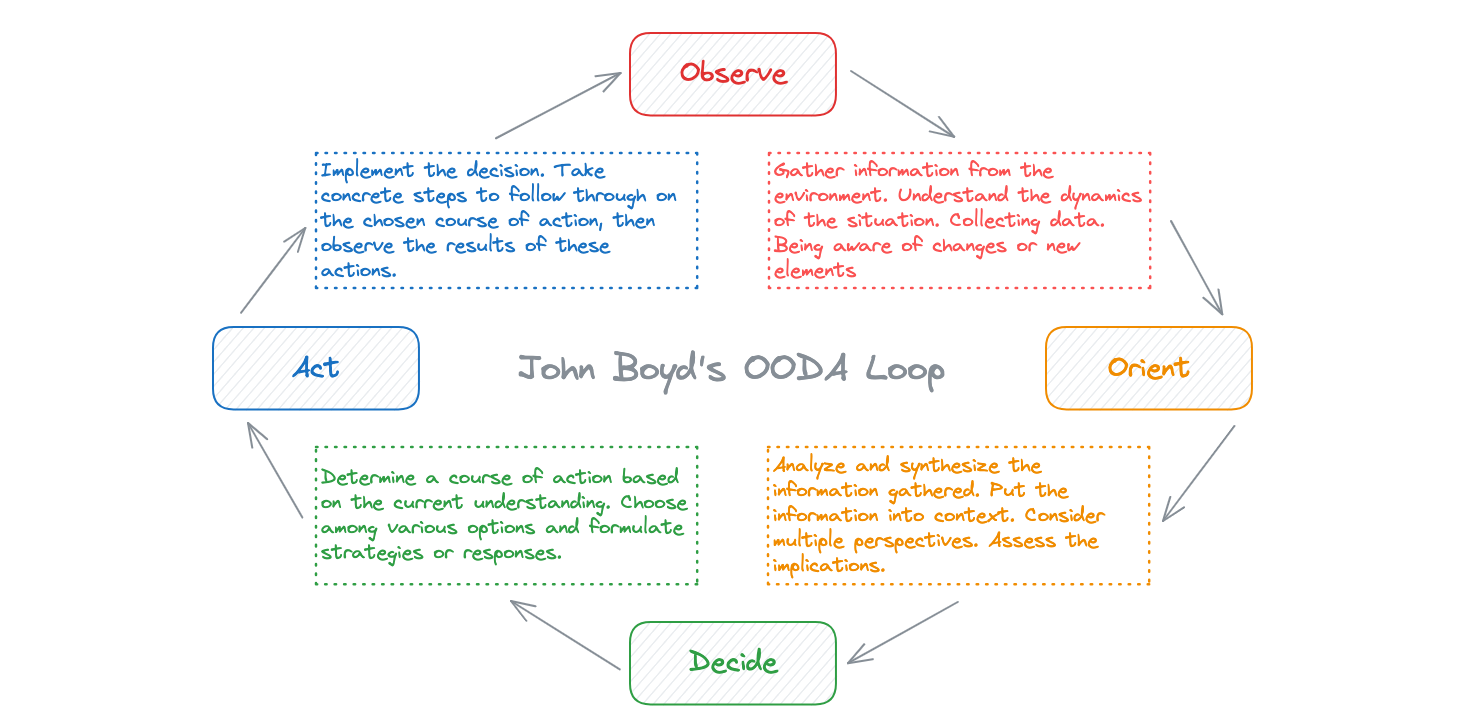The Concept You Must Know to be Successful in Mobile Gaming
In today's dynamic world of mobile gaming, the speed of iteration and adaptation is paramount. For product managers, studio executives, and live-ops teams aiming for the pinnacle of success, a mid-20th-century concept developed by US Air Force Colonel John Boyd might hold the key: The OODA loop. Standing for Observe, Orient, Decide, Act, this model can greatly enhance a team's agility, enabling quicker responses to user behaviors and market shifts.
What is the OODA Loop
The essence of the OODA loop is continuous feedback and adaptation.
Observe
Gather information from the environment. Understand the dynamics of the situation. Collecting data. Being aware of changes or new elements
Observe for Gaming
In managing a game, this involves monitoring player behaviors, preferences, game performance metrics, market trends, and feedback to understand the current gaming environment and player needs. Additionally, you must also observe market trends and competitor activities to understand the broader context.
Orient
Analyze and synthesize the information gathered. Put the information into context. Consider multiple perspectives. Assess the implications.
Orient for Gaming
This step is about analyzing the collected data to understand the players' experience and preferences, assessing competitors' strategies, and aligning these insights with the game's goals and capabilities.
Decide
Determine a course of action based on the current understanding. Choose among various options and formulate strategies or responses.
Decide for Gaming
Based on the analysis, game managers make strategic decisions, such as introducing new features, adjusting game mechanics, planning marketing campaigns, or implementing monetization strategies.
Act
Implement the decision. Take concrete steps to follow through on the chosen course of action, then observe the results of these actions.
Act for Gaming
Here, the decisions are put into action, whether it's rolling out an update, launching a promotional event, or changing the game's pricing model, followed by closely observing the outcomes and impacts of these actions on the game’s performance and player engagement.
This model's brilliance lies in its cyclical nature—by the time one loop is completed, the next has already begun, ensuring the game stays relevant and captivating. It is crucial to iterate through this loop as quickly as possible.
Applying the OODA Loop to Mobile Gaming
Imagine a scenario where a new RPG mobile game experiences a sudden drop in player engagement during its third level.
- Observe: Analytics tools indicate players are abandoning the game at a specific stage.
- Orient: The live-ops team hypothesizes that the level's difficulty spike could be the culprit, deterring players from progressing further.
- Decide: The team decides to tweak the level's difficulty and introduce a mini-tutorial.
- Act: Using a remote configuration platform like Joystick, these changes can be implemented and AB tested in minutes, rather than waiting days or week for a software update. Using remote config is like having a cheat code for managing a game.
- Observe Again: After these changes, player retention past the third level improves dramatically, validating the team's hypothesis.
Using Remote Configuration Accelerates Your OODA Loop Cycles
While the OODA loop is a powerful model, its effectiveness in mobile gaming hinges on the tools at our disposal. Joystick stands out as a tool perfectly aligned with the OODA loop principles. It decentralizes decision-making, empowering team members closest to the players—those who observe and understand player behaviors firsthand—to make quick changes. No longer does one need to wait for a tedious code deploy; with Joystick, decisions can be oriented and acted upon in real-time, making the game's evolution truly dynamic.
The Strategic Significance of Remote Config in Mobile Gaming
Choosing to integrate a remote config platform like Joystick isn't just a tactical move—it's a strategic. Such tools don't just make life easier for developers; they redefine the entire game's life cycle. The increased agility they offer can significantly enhance user engagement, as changes based on player feedback can be rolled out almost instantaneously.
What's the Take Away?
For those in the mobile gaming industry, the OODA loop offers a blueprint for sustained success. By continuously observing, orienting, deciding, and acting, games can remain fresh, engaging, and profitable. However, all too often, the gap between "Decide" and "Act" is too long: days to weeks, or even months. With remote configuration tooling like Joystick, the gap is shorten to hours or even minutes. Embracing the OODA loop by integrating remote config is a strategic decision that will pay dividends, setting the stage for a game that evolves in-step with its players and the market.
Further Reading
Here are three great resources (that we have personally read) for learning more about the OODA loop.
- The OODA Loop: How Fighter Pilots Make Fast and Accurate Decisions
 Certain to Win: The Strategy of John Boyd, Applied to Business
Certain to Win: The Strategy of John Boyd, Applied to Business Science, Strategy and War: The Strategic Theory of John Boyd
Science, Strategy and War: The Strategic Theory of John Boyd
Get Started with Joystick Today
30k requests per month included. No credit card required. No per-seat charges. Usage-based pricing.

